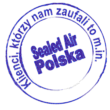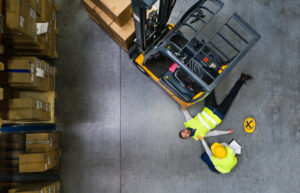Definition of health and safety
Occupational health and safety - it is a set of general provisions setting out general rules for performing work in a safe and hygienic manner. The Central Institute for Labor Protection defines occupational health and safety as a set of legal standards as well as research, organizational and technical measures aimed at providing the employee with appropriate working conditions so that its performance is as productive as possible. The main goal of OHS is also to create conditions for the employee that exclude all kinds of dangers or excessive mental or physical burden, as well as the neutralization of stimuli that may lead to an occupational disease.
What is OHS?
Occupational health and safety is defined as a fully independent scientific field, the main goal of which is to shape knowledge in the field of appropriate working conditions. This science deals with issues from many related fields, such as: ergonomics, labor economics, occupational medicine, occupational psychology or technical safety.
Health and safety regulations - legal regulations
- Constitution of the Republic of Poland,
- The Labor Code along with the code executive and pre-code regulations,
- Act on fire protection,
- Food and Nutrition Safety Act,
- separate acts in which the provisions on health and safety at work were presented,
- the regulation with a list of dangerous, burdensome or harmful to the health of pregnant women and women who are breastfeeding a child,
- regulation on health and safety for manual transport work,
- a provision having the nature of occupational health and safety contained in the collective labor agreement and work regulations,
- provisions having the nature of occupational health and safety contained in the agreement or the rules of teleworking.
The most important concepts in the field of health and safety
Work safety - it is a set of conditions necessary to be met and adhered to in the workplace in order to guarantee the safety of people working and staying on the premises of the workplace. In Poland, the organization responsible for safety in workplaces is the National Labor Inspectorate.
Occupational hygiene - the concept of hygiene comes from the Greek word hygieinos, translated as "healthy". Currently, the responsibilities of people involved in occupational hygiene include: testing the intensity of factors detrimental to health, determining health hazards in the work environment and prophylaxis in the field of pro-health activities.
The concept of well-being - well-being is made up of the conditions necessary to maintain full health. The lack of at least one element may affect its violation. When problems arise in the workplace, they can induce disease states. Each workplace should take care of the well-being of its employees, because it is only thanks to it that effective work is possible.
Physical well-being - it is responsible for providing the employee with appropriate working conditions that will not adversely affect his physiological life processes. Physical well-being includes, for example: air conditioning in a sunny room, access to a toilet and hygiene products, as well as providing a place where the employee can eat a meal in peace.
Mental well-being - an important issue is to maintain the appropriate mental well-being of the employee. The pleasure of work and the possibility of development and self-fulfillment help in getting rid of stress and the resulting health consequences.
Social well-being - it concerns the sphere of emotions, every person should feel needed and appreciated in their workplace. The employer should have a kind of bond with co-workers. Support in difficult and stressful situations enables efficient problem solving and positive functioning in the professional group.
Necessary information on the OHS course intended for people who perform particularly dangerous work.
Currently, many organizations and companies organize courses in the field of occupational health and safety. Our company decided to organize health and safety course for people who deal with particularly dangerous jobs that endanger their health and life on a daily basis. The training is carried out in the form of instruction, classes are conducted by a specialized team of experts in the field of health and safety and Fire protection. The trainings are open and are conducted every day at a convenient time and place, both for companies and individuals. The main aim of the training is to update, enrich and supplement the knowledge and skills in the field of health and safety. The thematic scope of the course includes:
- legal and organizational requirements for units performing particularly dangerous work,
- identification and assessment of the degree of risk during particularly hazardous work,
- skills in operating the equipment and using personal protective equipment necessary for high-risk works,
- safe organization of particularly hazardous work.
The health and safety training program includes:
- legal regulations concerning occupational health and safety based on regulations related to the performance of particularly dangerous works,
- threats of factors occurring at the time of performing particularly dangerous works,
- use of personal protective equipment,
- rules of conduct in the event of accidents
- first aid rules
- circumstances and causes of accidents during particularly dangerous works
- preventive measures, fire protection during particularly dangerous works.
List of works involving particularly high risks to the safety or health of workers:
- construction, demolition, renovation and assembly works, carried out without stopping the operation of the workplace or its part;
- in tanks, canals, interior of technical devices and other dangerous closed spaces;
- when using hazardous materials;
- On the height;
- inside the furnace chambers of boilers, flue gas ducts, electrostatic precipitators, boiler drums, bunkers, channels and hoppers, and in liquid and gaseous fuel tanks;
- inside the bunkers of coal, coal dust, slag and ash as well as other tanks and rooms where poisonous, corrosive, asphyxiant, flammable or explosive gases or liquids may be present;
- in the coal dust preparation circuits, inside coal mills, at mill fans, cyclones and separators;
- requiring the uncovering of turbine casings, removal of turbine and generator rotors as well as repair and balancing of these rotors;
- in the water circuits of power plants and combined heat and power plants, requiring entry into channels, pipelines, suction pipes and tanks, as well as work on intakes and water discharges from jetties, boats or barges and carried out under the water surface;
- maintenance, modernization and repair of power devices that are under voltage;
- performed in the vicinity of unshielded power devices or their parts that are under voltage;
- with de-energized, but not earthed, power equipment or earthed in such a way that none of the earthing devices - earthing devices is visible from the workplace;
- when lowering and suspending cables on overhead power lines disconnected from voltage in the spans crossing railway, water and road roads;
- related to the identification and cutting of power cables;
- when welding, soldering, replacing racks, as well as individual cells and the entire battery in accumulators.



































